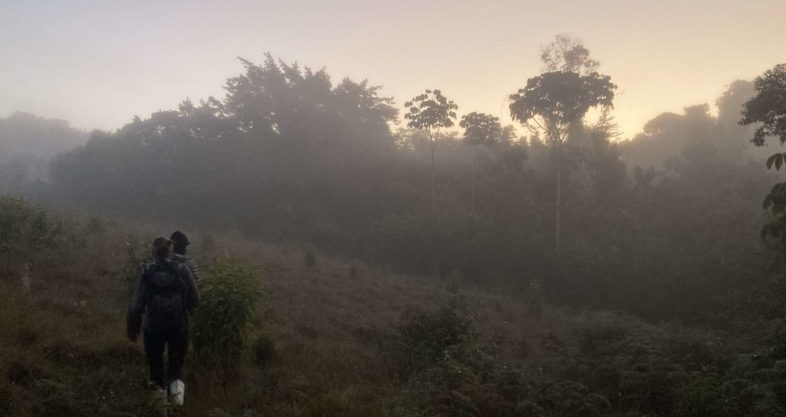
The morning mist at Reserva Privada Zorzal © Kevin Tolan
The morning after bidding farewell to half of our caravan from the past week of chasing birds through the Dominican Republic’s cloud forest, we headed north toward Santiago. Our home for the second week of nanotag deployment was Reserva Privada Zorzal, located 120 miles as the bird flies (and 10 hours by car) northeast of Sierra de Bahoruco. Situated 320 m above sea level, this preserve sits at just one-fifth the elevation of our Bahoruco study site. Data from VCE’s past fieldwork and modeling were integral to establishing this first-of-its-kind private preserve in the Dominican Republic; 70% of its 1,019 acres are set aside as “forever wild” habitat for Bicknell’s Thrush (BITH; zorzal means “thrush” in Spanish). Unlike the patchy montane cloud forests of Sierra de Bahoruco to which we had grown accustomed, Reserva Zorzal is a mixed rainforest of mid-elevation, second-growth broadleaf and sustainably-grown cacao. We relegated last week’s experience of awakening in our ice-coated tents to distant memory; the preserve offered a bunkhouse, electricity, and running (albeit unheated) water.
Our change in scenery was accompanied by a change in species assemblage. Gone were the screeching flocks of Hispaniolan Parakeets and Parrots, replaced by the gentle cooing of Ruddy Quail-Doves. Narrow-billed Todys were joined by their lower elevation Broad-billed counterparts, and a plethora of familiar neotropical migrants dotted the landscape, including Yellow-rumped, Black-throated Blue, and Cape May Warblers. A pair of Hispaniolan Giant Treefrogs (Osteopilus vastus) dutifully guarded their eggs in a stream that bisected the study site. Large purple orchids (Spathoglottis plicata), beautiful though introduced, were scattered across the forest floor.
Although BITH are present in broadleaf forests across the elevational gradient, habitat quality is unequal. High-elevation forests (such as those found in Sierra de Bahoruco) are generally less susceptible to degradation and have significantly more arthropods than lower-elevation rainforests, which are often subject to clearing for agriculture. Male BITH, which are larger and more aggressive than females, are thought to out-compete females in this “higher quality” habitat. This skewed habitat usage makes protected mid-elevation habitats, such as those found in Reserva Zorzal, extremely valuable for female BITH as they provide proportionally more habitat. VCE scientists and colleagues estimated that five times more females overwinter in mid-elevation rainforests than in higher-elevation cloud forests.
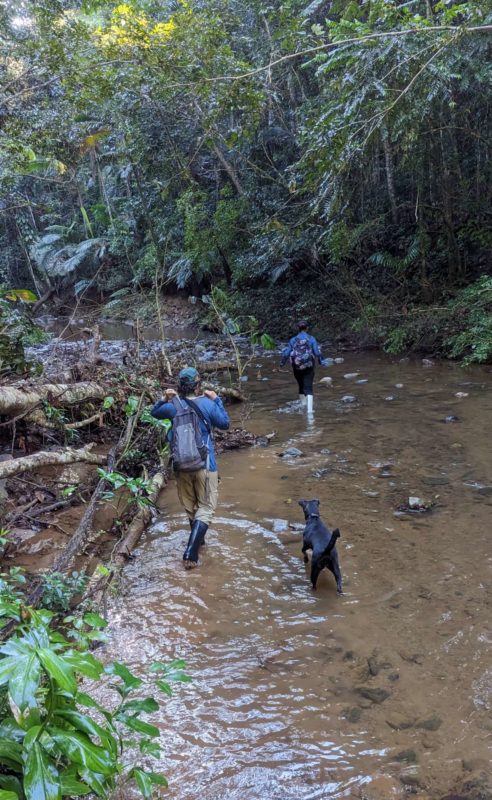
Hodali, Yoli, and Mila crossing a brook in Reserva Zorzal © Pablo Feliz
While only two of our colleagues from Grupo Jaragua could join us in the field during this second week, Hodali Almonte was a welcome addition. Hodali, the Curator of Ornithology at the Dominican Republic’s National Museum, is intimately familiar with the preserve and its birds, particularly wintering BITH. Throughout her studies of BITH’s diet (they consume more fruit than their higher elevation counterparts), Hodali has transected the entire preserve while performing point-count surveys and mist netting.
In Bahoruco, we had the benefit of using established trails and roads as net lanes; however, established trails are nonexistent throughout most of Reserva Zorzal. The trails we bushwhacked often bisected scattered remnants of barbed wire fences—a relic of the preserve’s agricultural past—and took us through stands of spiny tree ferns. Our local guide, Bernardo Alvarado, had accompanied Hodali on many of her excursions, and his familiarity with the preserve’s terrain was tremendously helpful to us.
Hodali’s past work informed our choice of targeted survey locations. Given the proclivity of these birds to return to the same wintering area, and the patchiness of the habitat, certain sections of the preserve were known to have prime, occupied habitat. Rare among migratory birds, BITH hold territories on their wintering (not breeding) grounds. Unlike our summertime array of stationary mist nets on Mount Mansfield, we targeted individual territorial birds. Capitalizing on territorial BITHs’ aggressiveness, we used playback recordings to lure them into the net. Once captured, we affixed a metal leg band and 0.85g radio tag to the birds.
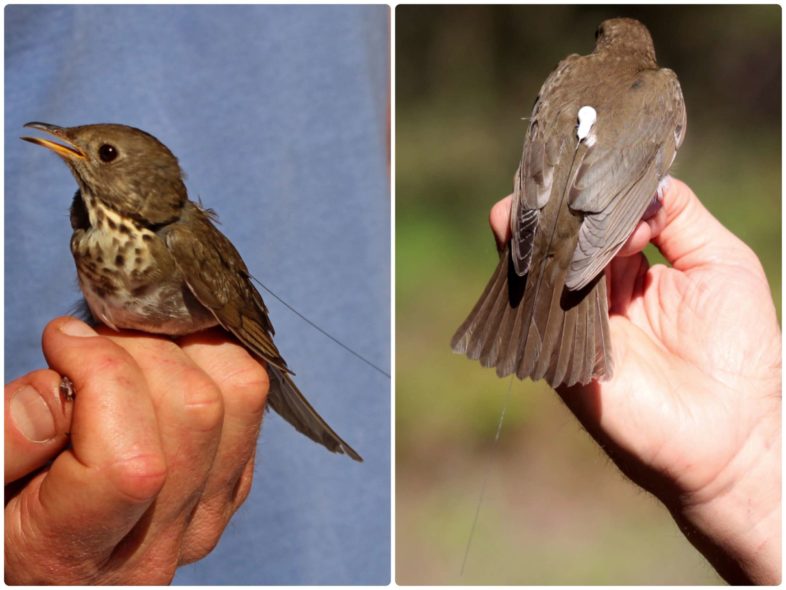
A Bicknell’s Thrush sporting a newly deployed nanotag © Yolanda León
These radio tags are not the same GPS tags VCE deployed on Mount Mansfield in 2021 and 2022. These so-called “nanotags” utilize the Motus network, a rapidly expanding array of over 1,000 radio receivers that “ping” when a nanotagged bug, bat, or bird passes nearby. While VCE has a rich history of tracking BITH throughout their lifecycle, the evolving Motus technology will help fill a critical missing piece of their migratory story, thanks to the way the data is communicated. Unlike our archival GPS tags that we must retrieve to collect any data, we don’t need to recapture these nanotagged birds to access their valuable data.
Come May, when our tagged birds make their way northward along the Atlantic coast, their tags will share data to the cloud via the Motus network. This will provide us with information about the timing and location of their migratory movements for up to one year. As it happened, many birds we captured and nanotagged from both sites hatched in 2022. Before nanotagging technology was available, we chose not to deploy archival tracking units on yearlings because their natal philopatry (return to their birthplace) is relatively low, meaning the likelihood of recovering their tags and data is slim. With any luck, these young birds will shed new light on their age cohort’s lifecycle.
Despite Motus’s benefits, this tracking method has some major limitations. For one, it doesn’t work where there aren’t receivers. Cuba, Hispaniola, Jamaica, and the Bahamas currently lack Motus towers, meaning there’s a large spatial coverage gap across much of BITH’s winter range. Additionally, because the spatial data have a radius of up to roughly 15 km, the data are generally unsuitable for tracking fine-scale movements. Yet, Motus towers are abundant across the US eastern seaboard, so these nanotags will likely address key questions about the migratory pathways connecting breeding and wintering ranges.
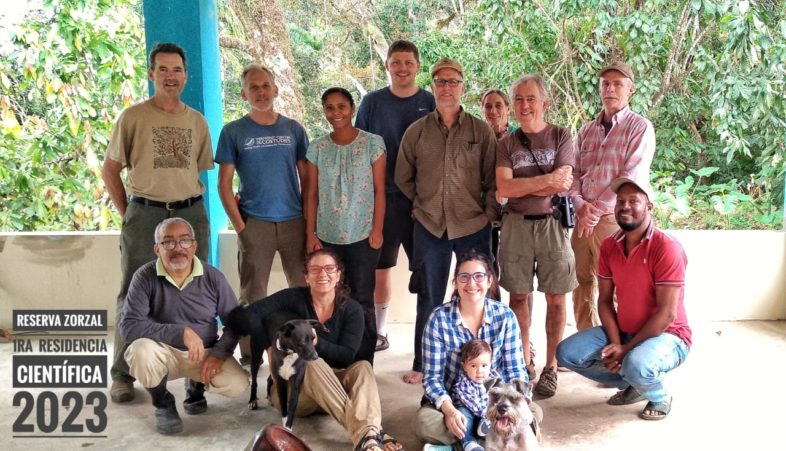
The Reserva Zorzal crew © Reserva Zorzal
We wrapped up our time at Reserva Zorzal and, along with it, our banding excursion, which added seven newly tagged birds to the 14 from our previous week in Bahoruco. Despite numerous agonizingly close calls, we still managed to eke out a grand total of 21 tagged birds. Although we deployed fewer nanotags than we had hoped, the freshly outfitted birds will provide valuable data to inform future conservation efforts.
The morning of our departure, Banaquits greeted us in the airport parking lot, and a swarm of Antilean Palm Swifts showed us to our gate. As we flew back across the Atlantic, tracing a route similar to the Blackpoll Warbler’s southward migration, I thought ahead to the upcoming season on Mount Mansfield. Between recovering GPS tags, returning migrants, and these newly nanotagged birds, we’re poised to collect some exceptionally informative data on the movements of Bicknell’s Thrush. Please wish our birds a safe journey, and hopefully, we’ll see them again.
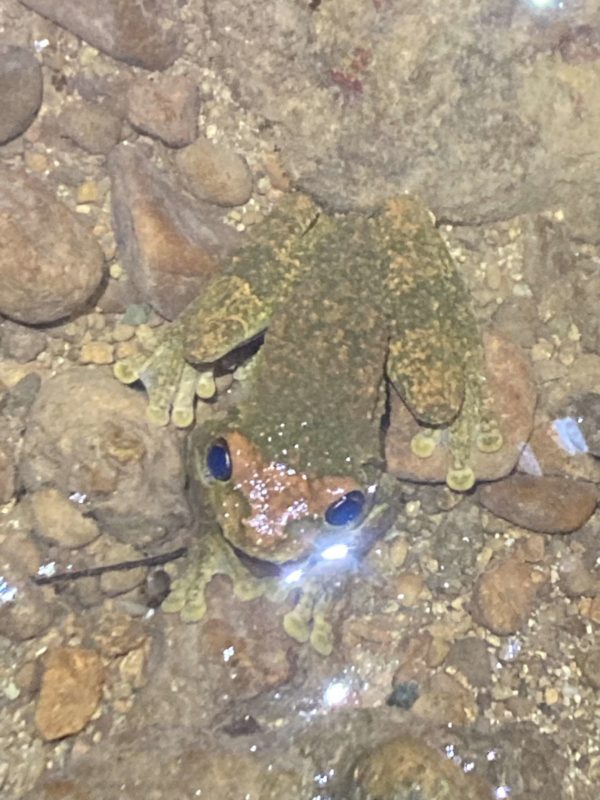

Really interesting and fun report Kevin. Thanks for all your hard work.
Awesome BITH team! thanks so mu
so much! (distracted by squirrel) : )